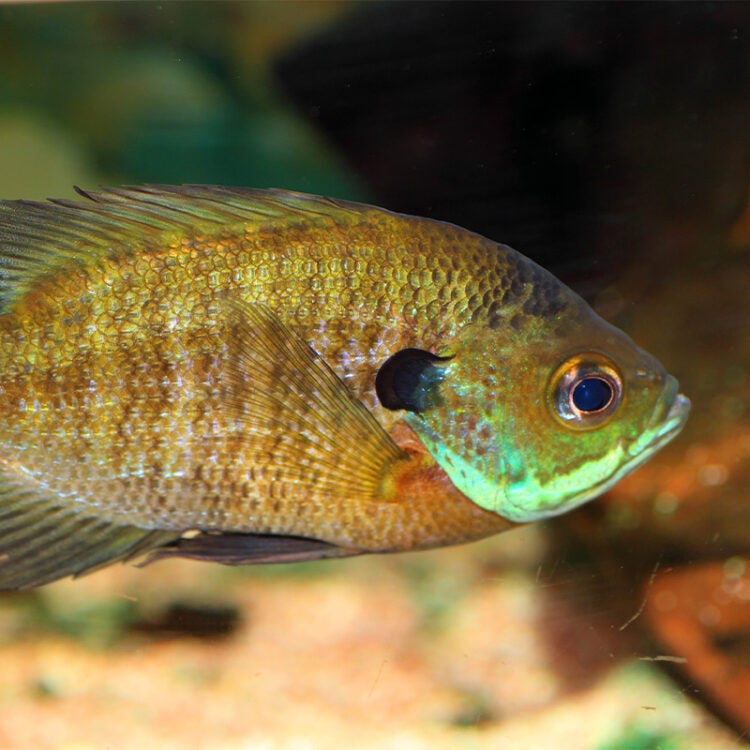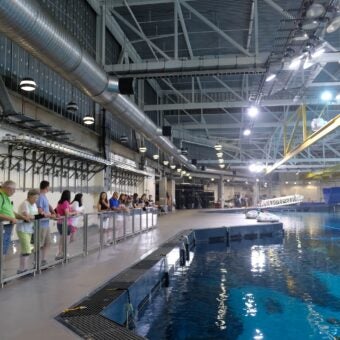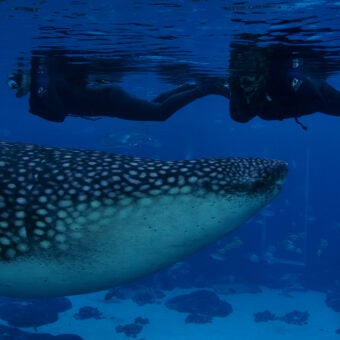-
Size
9.5 inches (24 cm) -
Diet
Snails, small fish and invertebrates -
Range
North America -
Habitat
Lakes, ponds, reservoirs, sluggish streams
Physical Characteristics
- Adult bluegills weigh about 12 oz. (0.3 kg) and reach about 9.5 inches (24 cm) in length.
- This species may be distinguished from most other sunfish by the dark spot on the posterior end of the dorsal fin, dark vertical bars on its sides that fade into the belly and a relatively small mouth.
- Distinguishing fin spot is faint on a young fish and the dark side bars are thinner.
- Its back and upper sides are usually dark olive green blending to lavender, brown, copper, or orange or, in some individuals, an overall blue body sheen with yellow and green flecks on the sides. The bluegill has a white to yellow color on the belly.
- The body is extremely laterally compressed and sometimes displays two blue streaks from its chin to the edge of its gill cover.
- Long, pointed pectoral (side) fins.
- A breeding male’s color pattern has a blue head and back, a bright red-orange breast and belly, with black pelvic fins.
Animal Fun Fact
A breeding bluegill male’s color pattern has a blue head and back, a bright red-orange breast and belly, with black pelvic fins.
Diet / Feeding
- Adult feeds on snails, small crayfish, insects, spiders, worms, fish eggs and small minnows.
- Juveniles feed on crustaceans, insects and worms.
- Feeds primarily near vegetation or another cover.
- This fish will shift from one feeding area to another quickly, depending on food abundance. When food is abundant it will eat larger prey items but will optimize its foraging strategy and be less selective when food is less abundant.
Range / Habitat
- Occurs in the St. Lawrence, Great Lakes and Mississippi River basins and from Quebec to northern Mexico.
- Found in lakes, ponds, reservoirs and sluggish streams, specifically in vegetated areas. It is most abundant in lakes and ponds with shallow water that is near the cover of vegetation, submerged wood, or rocks.
- Also occurs in the less brackish (lower salinity) portions of coastal estuaries.
Reproduction & Growth
- Bluegill spawning takes place from April to September.
- It is the male’s responsibility to pick a good nesting spot and build the nest.
- He often prefers to build in areas where other bluegills have constructed their nests, which sometimes creates a network of “honeycombed” nesting sites.
- The female lays her eggs in the nest and the male guards them until they hatch. He continues his watch even after the young emerge.
- Non-nest-building males occasionally mimic females by assuming their coloration and behavioral patterns.
- The mimics will enter the nests of the nest-building males and circle with them as if spawning.
- When the females enter the nests, the mimic apparently participates in fertilizing the eggs.
Conservation Status
- “Least Concern” on the IUCN Red List.
Additional Information
- Bluegills are a popular sport fish in the U.S. and may account for more individual catches than any other game fish.
- It is a member of the sunfish family whose members are commonly referred to as “sunnies.”
- Average lifespan of the bluegill is five to six years.
- Juvenile bluegill are often prey for birds, water snakes and larger fish.
- This is the state fish of Illinois.
Sources
- www.tpwd.state.tx.us/fish/infish/species/bgl/bgl.htm
- www.dnr.state.md.us/fisheries/education/bluegill/bluegill.html
- www.museum.state.il.us/exhibits/symbols/fish.html
- www.fishbase.org
- The Fishes of Tennessee. Etnier, D. A. and Starnes, W. C., pgs. 417 – 419
-







